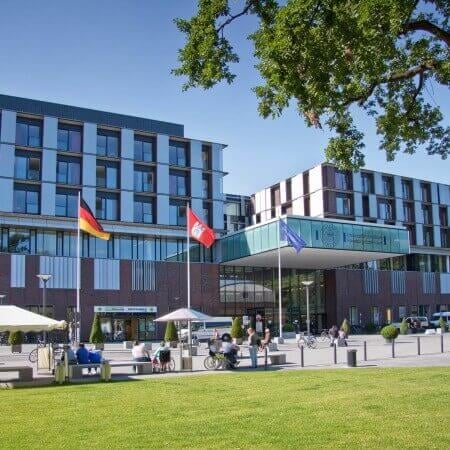Ear cancer is a rare group of malignant tumors. Most often, the neoplasm develops in the auricle and external auditory canal. Occasionally, neoplasms develop in the middle ear. The main and most effective treatment method is the surgical removal of the neoplasm. Surgery is often followed by radiation therapy. In the case of inoperable cancer, chemoradiotherapy becomes the main treatment method.
Content
- What is ear cancer?
- Diagnostics
- Principles of treatment
- Surgical treatment of ear cancer
- Radiation therapy
- Chemotherapy
- Why is it better to treat ear cancer abroad?
- Treatment in Europe with Booking Health
What is ear cancer?
Ear cancer is a rare disease that accounts for 0.2% of all head and neck tumors.
The most common type of cancer is malignant tumors of the outer ear. These neoplasms account for 90% of cases. Many cases are skin cancer localized in the ear. Therefore, such histological types as basalioma and squamous cell carcinoma predominate in the structure. They account for more than 60% of all ear cancer cases. Glandular cancer is less common – almost 40% of cases. Other types of malignant tumors, such as melanomas and sarcomas, are rare in the ear.
Outer ear cancer is aggressive. It quickly spreads to adjacent organs such as the mastoid process, parotid gland, temporomandibular joint, bone structures of the skull, brain meninges, and tissue.
Cancer in the outer ear develops for a long time unnoticed by the patient and does not cause any symptoms. Therefore, 40% of cases of the disease are detected in stage 4; 30% of cancer cases are detected in stage 3. At the time of diagnosis, in two out of three patients, cancer had already spread beyond the ear, making it difficult to treat the disease.
Stages of the disease:
- Stage 1 – the neoplasm is located only in the ear canal;
- Stage 2 – bone erosions are formed; the tumor grows into the tissues by no more than 5 mm;
- Stage 3 – the neoplasm spreads to the middle ear; the tumor grows into the tissues by more than 5 mm;
- Stage 4 – spread to the inner wall of the middle ear, inner ear, petrous part of the temporal bone, carotid canal, parotid gland, facial nerve.
In 10% of cases, middle ear cancer develops. The most common is squamous cell carcinoma. Glandular neoplasms are diagnosed as rare.
Diagnostics
Ear tumors account for up to 70% of all cases. They are detected earlier, as tumors are visible during a visual examination. They can be seen by the patient, and also detected by the doctor. To confirm the diagnosis, doctors perform a biopsy. If the tumor is small, it can be completely removed, and after surgery, the diagnosis is confirmed by histological examination.
Tumors of the external auditory canal and middle ear are not detected during a routine diagnostic examination. They do not manifest any symptoms for a long time. The reasons for patients to seek medical help are as follows:
- earache;
- itching;
- bleeding;
- inflammation, sometimes with pus discharge;
- hearing loss, if the neoplasm reaches a large size and compresses the ear canal.
Some patients already have metastases at the time of going to the doctor. In this case, neck swelling develops, and enlarged lymph nodes are palpated.
Otoscopy helps to see the tumor, while a biopsy is required to confirm the diagnosis. The doctor receives a tissue fragment and sends it for histological examination. As a result, not only is the diagnosis confirmed but also the histological type of the tumor is determined.
To clarify the diagnosis, the doctor needs to clarify the size, shape, localization of the neoplasm, spread to the surrounding tissues, and detect metastases also. Contrast-enhanced computed tomography is most often used for this purpose. It is the most informative diagnostic method. However, if there are contraindications, an MRI may be performed as well.
Principles of treatment
The most effective is a combination treatment that includes surgical resection of ear cancer and postoperative radiation therapy. It is also possible to use chemotherapy together with postoperative radiation.
As an alternative treatment method, patients are offered chemoradiotherapy without surgery. It provides better results compared to surgery alone. Nonetheless, the results are worse than the combination of surgery and radiation therapy. Therefore, non-surgical chemoradiotherapy is mainly performed in patients who are debilitated by the disease or have comorbidities, which make traumatic surgery too risky for health.
Some patients refuse surgery due to the risk of complications. With ear cancer that has spread beyond the external auditory canal, the scope of tissue resection is quite large. Therefore, some patients develop complications: meningitis, cerebrospinal fluid leak, encephalitis, cerebral infarction, deafness, and facial nerve paralysis. Radiation therapy provides a safer treatment and does not require a long recovery.
The prognosis for patients depends on the stage and location of the tumor. Middle ear neoplasms are more difficult to treat. The five-year survival rate for patients is 20%. Outer ear tumors have a better prognosis. After surgery and radiation therapy, even at stage 3, the five-year survival rate of 60% is achieved; in stage 4 it reaches 40%. When the neoplasm is detected at stages 1-2, this figure is 85%.
Surgical treatment of ear cancer
Cancer of the ear localized in the auricle is the most favorable prognostically. It can be treated surgically, as most tumors are detected on time, at stage 1 or 2.
Tumor resection. The surgical intervention allows for the tumor removal with a negative resection margin in 95% of cases. Relapses are rare. Ear neoplasms grow along the embryologic fusion planes. The skin here is thin, so cancer quickly penetrates the subcutaneous layer. Due to this, the indentation of healthy tissues is done more than with the localization of cancer in other areas of the face. With a basalioma of up to 3 cm, the indentation is at least 8 mm, and with a size of more than 3 cm, the indentation of at least 1.5 cm is made to avoid recurrence. With squamous cell carcinoma, which is more aggressive and recurs more often, the indentation is even greater: from 2 cm. At high risk of recurrence, the tumor is resected with wide surgical margins.
Auricular reconstruction. Cancer removal in this area leads to aesthetic defects. They can affect only the skin and perichondrium, and after the large tumors removal, full-thickness defects may be formed throughout the entire thickness, since doctors also remove cartilage. Non-penetration defects of the ear are closed with skin flaps. Full-thickness defects often require autologous cartilage transplantation. Foreign specialists successfully reconstruct the ear even in patients with large auricular defects.
Lateral temporal bone resection. It is a treatment method for ear cancer that is limited to the external auditory canal without spreading to the middle ear. The surgical intervention involves the removal of the external auditory canal, eardrum, and auditory ossicles. The anvil and stirrup are separated. Sometimes a nearby parotid gland is removed during surgery. Doctors have to bypass the facial nerve carefully, which runs in its thickness. There may be neurological symptoms after surgery. However, facial numbness resolves after a few weeks if nerve integrity is maintained or restored.
Subtotal temporal bone resection. It is used for tumors that have spread to the middle ear. Doctors remove the external auditory canal, the tympanic membrane, all structures of the middle ear, as well as the structures of the inner ear. The resection is limited to the internal carotid artery. It passes through the petrous part of the temporal bone.
Total temporal bone resection. It is the most radical treatment for patients suffering from ear cancer. It is used for tumors that affect the top of the petrous part of the temporal bone, spreading into the skull or the infratemporal fossa. The operation includes resection of the petrous part of the temporal bone. It can be performed with or without carotid artery resection. The stylomastoid foramen is included in the removed tissue fragment. Sometimes doctors also have to perform resection of a part of the dura mater and facial nerve, as well as the parotid gland.
Neck dissection. It is an additional stage of the operation aimed at the removal the lymph nodes of the neck. Neck dissection is not required for all patients. The neck's soft tissues with lymph nodes are removed only with the signs of metastasis detected. The dissection is performed in different scopes, depending on the stage of ear cancer. It can be selective, modified, or radical dissection. The more tissue removed, the lower the risk of tumor recurrence, but the more traumatic the operation and the higher the risk of irreversible side effects. Therefore, doctors strive to perform the removal of the minimum amount of tissue that would cure ear cancer.
Radiation therapy
Doctors use radiation therapy for ear cancer in the following situations:
- after surgery, to reduce the risk of recurrence;
- as part of chemoradiation therapy, as the main method of treatment for ear cancer (with contraindications to surgery or refusal of it);
- before surgery to reduce swelling;
- as a way to locally control advanced stage ear cancer.
Foreign hospitals use modern methods of radiation therapy: 3D CRT, IMRT, and proton therapy are available in some specialized centers.
3D CRT is the standard radiotherapy in developed countries. Irradiation is planned in a three-dimensional model, which ensures high dose conformity.
IMRT is an improved version of 3D CRT. It is irradiation in three-dimensional mode, with the ability to adjust the intensity of individual beams. Doctors can safely destroy even complex tumors. The main advantage of IMRT for ear cancer is the possibility of reducing the radiation load on organs at risk, especially the structures of the central nervous system, such as the brainstem.
Here is what doctors irradiate:
- external auditory canal;
- total tumor volume (in patients who did not undergo surgery);
- tumor bed (after surgery);
- lymph node area – only if there are signs of metastasis.
Radiation is often used as the primary treatment option for stage 3-4 ear cancer when surgery is considered inadvisable. As a rule, doctors do not resort to it if:
- the neoplasm has spread to the dura mater with a large amount of its lesion;
- the tumor has penetrated the temporal lobe of the brain;
- revealed signs of tumor growth in the posterior cranial fossa;
- diagnosed involvement of the sigmoid sinus in the oncological process.
Some hospitals use proton therapy instead of photon therapy. It is the safest among all types of radiation therapy due to less exposure to healthy tissues. Protons, unlike photons, release energy mainly inside the target. On the way to the tumor, passing through healthy tissues, the radiation is almost not released. It is especially important for ear tumors that are located near large vessels, nerves, and important organs, including the brain.
Chemotherapy
Сhemotherapy is not very effective for the treatment of ear tumors. But many doctors use it as an additional treatment method, mainly to improve the results of radiation therapy.
Below are some cases in which chemotherapy can be used:
- after surgical removal of the tumor, along with radiation therapy, to destroy the remaining cancer cells and reduce the risk of recurrence;
- with contraindications to surgery, as part of chemoradiotherapy;
- at the advanced stage of cancer.
Why is it better to treat ear cancer abroad?
Malignant tumors are rare. But one can find specialized centers abroad with extensive experience in their treatment. Head and neck tumor surgery is technically complex and not equally successful everywhere. Therefore, it is better to perform operations for ear neoplasms in good hospitals abroad.
Here are a few reasons why you should go abroad:
- extensive experience in surgery for ear tumor removal;
- minimal risk of complications;
- reconstructive plastic surgery is performed to restore the patient's appearance;
- the use of the latest types of radiation therapy;
- some centers offer proton therapy, which is the safest method of irradiating ear tumors.
Treatment in Europe with Booking Health
To undergo treatment for ear cancer in one of the European hospitals, you are welcome to use the services of the Booking Health company. On our website, you can find out the cost of treatment and compare prices in different hospitals to book a medical care program at a favorable price. Treatment in Europe will be easier and faster for you, and the cost of treatment will be lower.
Please leave your request on the Booking Health website. Our specialist will contact you and consult on treatment in Europe. The Booking Health company will fully organize your trip to another country. We will provide the following benefits for you:
- We will select the best European hospital, whose doctors specialize in the treatment for ear cancer.
- We will solve the language barrier problem, and we will ensure communication with the doctor of the European hospital.
- We will reduce the waiting period for the medical care program. You will receive treatment on the most suitable dates.
- We will reduce the price. The cost of treatment in Europe will be reduced due to the lack of overpricing and additional coefficients for foreign patients.
- We will take care of any organizational issues: we will prepare documents, meet you abroad and take you to the hospital, book a hotel, and provide interpreting services.
- We will prepare the program and translate medical documents. You do not have to repeat the previously performed diagnostic procedures.
- We will help you keep in touch with doctors after the completion of treatment in Europe.
- We will organize additional diagnostic examinations and treatment in European hospitals.
- We will buy medicines abroad and forward them to your home country.
Leading doctors from around the world will take care of your health. Booking Health specialists will help reduce the cost of treatment, organize your trip to a European hospital, and you can fully focus on restoring your health.
Authors:
The article was edited by medical experts, board certified doctors Dr. Nadezhda Ivanisova and Dr. Vadim Zhiliuk. For the treatment of the conditions referred to in the article, you must consult a doctor; the information in the article is not intended for self-medication!
Sources:
European Society for Medical Oncology
Cancer Research Institute
NORD - National Organization for Rare Disorders




















